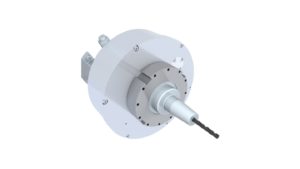Tomorrow’s industrial Internet will integrate technologies that imitate human cognitive skills such as the ability to plan, to learn, and to perceive our surroundings. The Fraunhofer Cluster of Excellence Cognitive Internet Technologies CCIT is working to realize the vision of a Cognitive Internet of Things.

Digitalization holds enormous potential for German industry, enabling companies to automate manufacturing processes, make them more efficient, adopt new business models, and offer customized products. “That calls for highly productive, cost-effective, flexible manufacturing processes, based on secure IoT technologies, trusted data infrastructures and reliable machine learning methods. We have all the expertise needed to do this at Fraunhofer CCIT and are researching specific application scenarios,” says Prof. Claudia Eckert, spokeswoman of the executive board.
Smart, interactive machine tools

Fraunhofer CCIT is developing a component for a smart tool that improves the quality and output of cutting processes. By integrating wireless components and wideband communication technology to measure the resonant frequencies of the tool, analyzing the data in real time, and detecting anomalies, it becomes possible to capture process data at the point of action. “This tells us immediately whether there is a problem with the machining process – for instance a defective tool,” says Hendrik Rentzsch of the Fraunhofer Institute for Machine Tools and Forming Technology IWU. Security protocols assure the integrity, confidentiality, availability and authenticity of the origin of the captured data. The IoT component functions both as a sensor and as an actuator. By emitting ultrasonic waves, it causes the tool to resonate. The resonance signals are amplified and can be used to control the tool. Rentzsch: “In this way it is possible to maintain a continuous level of quality and productivity even when the manufacturing process is running at full output. The solution developed by Fraunhofer CCIT can be integrated at little cost in any tool, for instance in a metal-drilling tool.”
Secure data sharing within a controlled user group
To illustrate the concept of a shared digital twin, Fraunhofer CCIT will be presenting its solution for a connected operations desk that allows companies to share sensitive data from their manufacturing processes with – and only with – authorized partners and customers. This IT solutions consists of three components: the IoT architecture, the digital twin, and the International Data Spaces (IDS). The RIOTANA® (Real-time IoT Analytics) architecture takes raw data from the process being executed – such as vibration, temperature or friction – and uses it to generate meaningful indicators in real time. This information is then stored in a digital twin on the company’s servers. Here, the company can define which data it wishes to share with which users and under what conditions. IDS connectors provide secure transmission of the data and control over further processing of the data by the recipient. Note that this data sharing is bidirectional. Information can also be added to the digital twin by external users. “Our technology creates a bridge between the IoT architecture and existing solutions for the secure exchange of industrial process data, such as the Industry 4.0 asset administration shell or the IDS architecture. It can accommodate any type of database or application. For example, it allows machine manufacturers and users to share process data in order to improve tool condition monitoring,” says Hendrik Haße of the Fraunhofer Institute for Software and Systems Engineering ISST.
Speedier results thanks to AI
But the added value of such technologies for industry extends beyond the ability to share data with outside partners. Technologies such as machine learning and artificial intelligence can be applied to the data obtained from ongoing manufacturing processes.
To ensure that machine tools produce reliable, reproducible results, signs of wear must be detected in good time. Until now, this depended on the experience and knowledge of the machine operator – and was mainly based on their powers of observation. Little was available in the way of technical aids. Researchers at the Fraunhofer Institutes for Production Technology IPT and for Algorithms and Scientific Computing SCAI have developed an algorithm for this purpose, which they trained using specially adapted machine learning methods. The AI is capable of determining a tool’s condition by analyzing its sound spectrum, which in turn enables it to identify even the slightest signs of wear. “Humans can do this too,” says Sebastian Mayer, a researcher at Fraunhofer SCAI, “but an AI can do it faster, and analyze many more sound spectra at the same time, as well as learning how to distinguish signs of wear on a finer scale. The algorithm helps the human operator to decide, for example, whether a tool needs to be replaced or not. “The AI is tuned to different frequencies than the human ear, and can advise the operator which frequencies should be given special attention,” says Fraunhofer IPT scientist Arno Schmetz.



